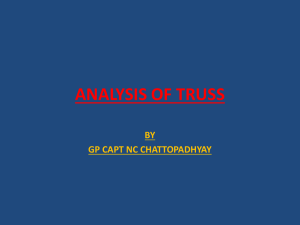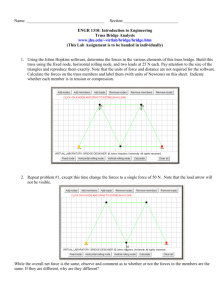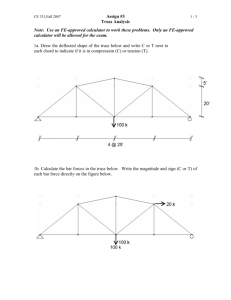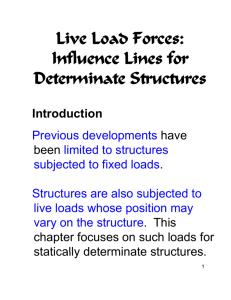Document
advertisement
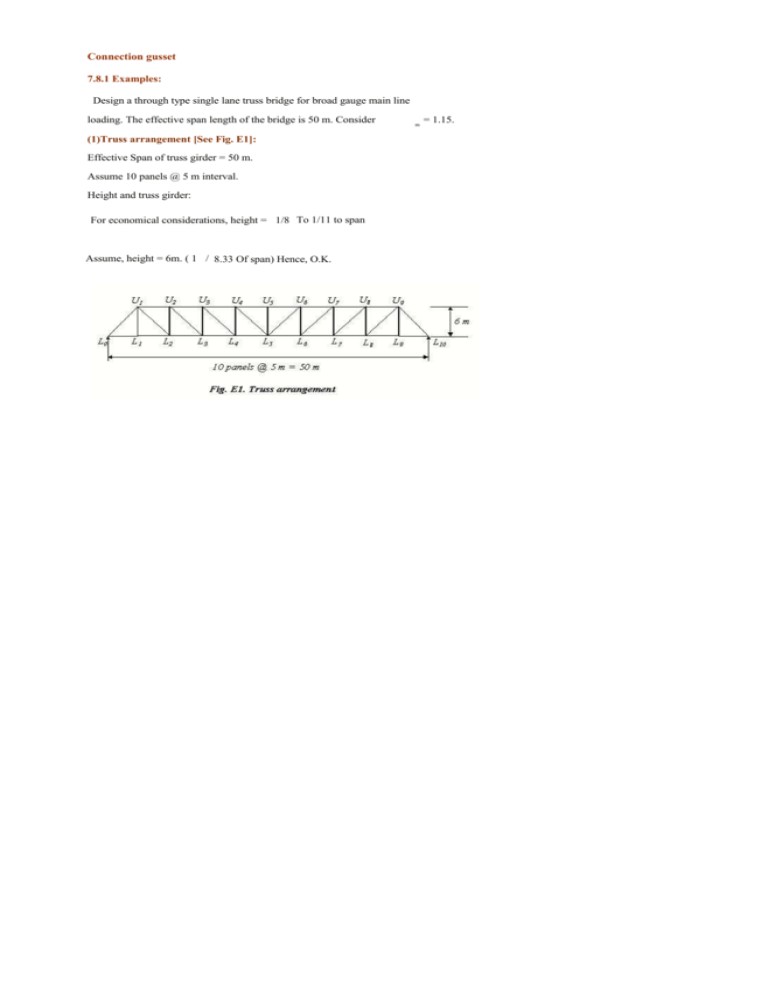
Connection gusset 7.8.1 Examples: Design a through type single lane truss bridge for broad gauge main line loading. The effective span length of the bridge is 50 m. Consider (1)Truss arrangement [See Fig. E1]: Effective Span of truss girder = 50 m. Assume 10 panels @ 5 m interval. Height and truss girder: For economical considerations, height = 1/8 To 1/11 to span Assume, height = 6m. ( 1 / 8.33 Of span) Hence, O.K. m = 1.15. (2) Influence line diagrams: (i) ILD for L0 U1 (Diagonal member): Fig. E2. Free body diagram (a) If, unit load is in between L 1 and L 10 (i.e. 5 = x = 50) V0= 1x LUsin 1 x/50 = - LU= 1-() 0 1 (b) If, unit load is in between L 0 and L son 50 1 (i.e) 0 =x 5= LU sin=-50 0 1 19x Then, we can get ILD as shown in Fig. E3. Fig. E3. ILD for L0 U1 (ii) ILD for L1 U1 (Vertical member): [See free body diagram Fig. E4] (a) If, unit load is in between L 0 and L 1 (i.e. 5 = x = 50) ML 0 = 0. 5L1 U1 = x L1 U1 = x / 5 (b) If, unit load is in between L 2 and L 1 Fig. E4 L 1 U1 = 0 Fig. E5 ILD for L 1 U1 (iii) ILD for U 4 U5 and L 4 L5 : (Top and Bottom chord members respectively) Fig. E6 Free body diagram (a) If, the unit load is in between L 0 and L 4 (i.e. 0 = x = 20) M0L5 = =1-() 6U 45 U 25 x+-*() 25 * 1 x / 50 1x UU 251=--25 x 45 650 () M0u4 = () () * 1 x / 50 = -20 6L 45 L 20 +x *1 1x LL 201=--20 x 45 650 (b) If, unit load is in between L UU 251 =45 Then, LL 201=45 ILDs for U 4 5 () and L 10 (i.e) 25 x==50 1x 650 1x 650 U5 and L 4 L5 are shown in Fig. E7 and Fig. E8 respectively. Fig. E7 ILD for U 4 U5 Fig. E8 ILD for L4 L5 (3) Loads: (i) Dead load - Dead loads acting on truss girder are as follows: Weight of rails = 2 x 0.6 = 1.2 kN/m. * Weight of sleepers = 0.25 x 0.25 x 7.5 / 0.4 = 2.34 kN/m. Weight of fastenings (assumed) = 0.25 kN/m. Weight of stringers (assumed) = 3.0 kN/m Weight of cross girders (assumed) = 5.0 kN/m. ** Self-weight of truss by Fuller’s Formula = 13.0 kN/m Total dead load per track = 24.8 kN/m Therefore, Total dead load per girder = 24.8 / 2 = 12.4 kN/m *[Assume 250 mm 250 mm 2m wooden sleepers @ 400 mm apart and weight of 7.5 kN/m 3 ] 15l ++ 550 15 x 50 550 == =kN / m ** Fuller 's Formula 13.0 100 100 (ii) Live load (a) Areas of Influence line diagrams for truss members discussed: Area of influence line for Area of influence line for 1 L01U x ==50 x1.17 29.3 2 1 LU x10x1.0 = =+ 5.0 11 2 Area of influence line for 1 U45U x 50 = =-x 2.08 52 2 Area of influence line for 1 L45L x50x2 = =+ 50 2 (Compression) (Tensile) (Compression) (Tensile) (b) Live loads and impact loads from IRS Bridge Rules - 1982: Live loads and impact factors for each loaded length are found from IRS Bridge Rules - 1982. For maximum forces in chord members, the whole of the span should be loaded and Live load is determined corresponding to maximum B.M. For other diagonal and vertical members, part of the span as indicated by influence line diagrams, should be loaded and the live load is determined corresponding to S.F. The impact factor is found corresponding to loaded length. For maximum force in members L 4 L5 and U 4 U5 : Load length = 50 m Live load for B.M. = 3895.2 kN Impact factor = 88 0.15 +=+ 0.15 =0.293 6l++ 650 (LL+ IL) per m per girder = + = 50.36 kN / m 3895.2 x (1 )0.293 2x50 For maximum force in members L 0 U 1 and L 1 U 1 : L0 U 1 Load length = 50 m Live load for B.M. = 4184.6 kN Impact factor = 880.15 +=+ 0.15 =0.293 6l++ 650 (LL+ IL) per m per girder = L1 U 1 : Load length = 10 m Live load for S.F. = 1227.8 kN 4184.6 x (1 )+ 0.293 = 54.1kN / m 2x50 mpact factor = 88 0.15 +=+ 0.15 =0.293 6l++ 650 (LL+ IL) per m per girder = )+ = 101.3 kN / m 1227.8x 1( 0.65 2x10 (c) Longitudinal Loads from IRS Bridge Rules - 1982 Assume, there exist rail expansion joints in the bridge and prevent the transfer of longitudinal loads to approaches. It may be noted that for broad gauge bridges upto a loaded length of 44 m, the tractive effort is more than the braking force and for loaded lengths more than 44 m the braking force is more than the tractive effort. Assume truss under consideration is simply supported by a hinge at L and a roller at L 10 . The longitudinal force in a member can be tensile or compressive depending on the direction of movement of train. Panel L 4 L5 : Loaded length = 30 m Tractive effort = 637.4 kN Force per chord = 637.4/2 = 318.7± kN Unfactored loads: Member Area of ILD Load in kN/m Forces in members (kN) DL LL+IL DL LL+IL Long.L L0 U 1 - 29.3 12.4 54.1 -363.3 -1585.1 - L1 U 1 +5.0 12.4 101.3 + 62 + 506.5 - U4 U5 - 52.0 12.4 50.36 -644.8 -2618.7 - L4 L5 + 50.0 12.4 50.36 +620 +2518 0 Use following Partial safety factors for the loads: DL = 1.35; LL = 1.50; = 1.50 LongL Factored loads: Member Factored Forces in members (kN) Total load (kN) DL LL+IL Long.L L0 U 1 -490.4 - 2377.6 - - 2868.0 L1 U 1 +83.7 + 759.8 - + 843.4 U4 U5 -870.5 -3928 - - 4798.5 L4 L5 + 837 +3777 + 5092 - 478 Note: Negative sign represents compression and positive sign represents tension. (4) Design for truss members: (i) Design of diagonal member (L 0 U1 ): Note that in this illustration of this Member, the portal effect and fatigue are not considered. Length of the chord, L 0 Assume, effective length, l U1 = l = 7810 mm e = 0.7*l = 5467mm Try a built up member with two ISHB350 spaced @ 300 mm A = 18442 mm r x = 146.5 mm r y = 158.8 mm x 2 = 5467/146.5 = 37.3 Then, s c = 221.8 N/mm 2 [See chapter on axially compressed columns using curve c] Axial capacity = (221.8/1.15)*18442/1000 = 3556.5 kN > 2868 kN Hence, section is safe against axial compression (ii) Design of vertical member (L 1 U1 ): Maximum tensile force = 843.4 kN Try ISMB 350 @ 0.524 kN/m shown. A = 6671 mm 2 Axial tension capacity of the selected section = 6671* 250/1.15 = 1450 kN > 843.4 kN Hence, section is safe in tension. [Note: Welded connection assumed] (iii) Design of top chord member (U 4 Member length, l = 5000 mm Assume, effective length = 0.85l = 4250 mm Try the section shown. A = 25786 mm 2 U5 ): r x = 165.4 mm r y x = 210 mm = 4250/165.4 = 25.7 Then, s c = 239 N/mm 2 [See chapter on axially compressed columns using column curve c] Axial capacity = (239/1.15)*25786/1000 = 5359 kN > 4798.5 kN Hence, section is safe against axial compression (iv) Bottom chord design (L 4 L5 ): Maximum compressive force = 478 kN Maximum tensile force = 5092 kN Try the box section shown. A = 25386 mm r x = 144 mm r y = 210 mm 2 Axial tension capac ity of the selected section = 25386* 250/1.15 = 5518 kN > 5092 kN Hence, section is safe in tension. Maximum unrestrained length = l = 5000 mm x = 5000/144 = 34.7 Then, s c = 225 N/mm 2 Axial capacity = (225/1.15)* 25386/1000 = 4967 kN > 478 kN Hence, section is safe against axial compression also. The example is only an illustration. The following have to be taken into consideration: ·Design of lacings/batten · Design of connections and effect of bolt holes on member strength · Secondary bending effects · Design for fatigue


